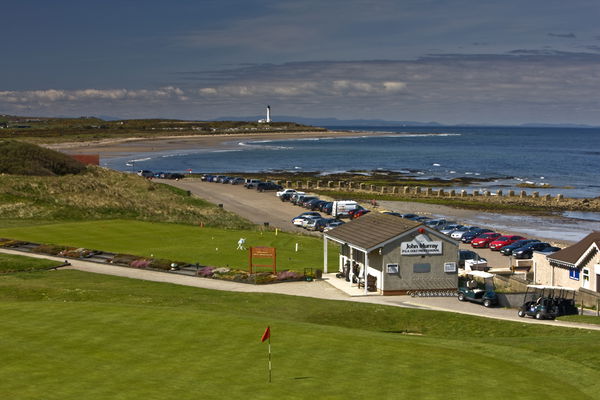Moray Golf Club, The Old Course: review
A real gem: Moray Golf Club in Lossiemouth

The Old Course at Moray Golf Club is a 6,572-yard par-71 championship links course in northern Scotland that sits at the end of the malt whisky trail on the Moray Forth – a golfer’s paradise. The course has hosted the Northern Open, the Scottish Professional Championships, the Scottish Strokeplay Championships as well as PGA Europro Tour events, and it is easy to see why as soon as you step onto the first tee.
I was accompanied round by John Thomson (Moray’s vice-captain and owner of the next-door Links Lodge B&B) and PJ, a Yorkshireman never short of a word of advice. Their sound advice helped me negotiate this challenging course for the most part, but even these veterans of golf on the Moray Firth couldn’t prevent the odd lost ball.
There are numerous bunkers dotted around the Old Course, although none will catch you out unexpectedly as they are all clearly visible. In fact, the members will tell you the bunkers should not be feared, but used to your advantage as reference points in deciding how to plot your way around this 124-year-old course.
The first hole, a short 316-yard par-4 running parallel to the beach, should not cause too many problems so long as you avoid the heather and gorse right of the fairway. Most will be left with just a wedge or a short iron approach shot into one of the flatter greens on the course. A gentle start, but don’t get complacent…
The second is the first of the par-5s which, although not the longest, requires accuracy off the tee, as there are plenty of bunkers lining the fairway as well as thick gorse running down the length of the hole on both sides. A good tee shot may tempt longer hitters to take on the bowl green in two, but those who do also risk running into trouble as an out-of-bounds road runs adjacent to the left side of the green. A good risk-and-reward hole – and a blob on my scorecard!
If the second green was inviting, then the third is quite the opposite. This dog-leg par-4 requires a very good second shot if you’re to have a chance of making par. The elevated green slopes steeply back towards the fairway at the front before flattening out, necessitating a well-judged approach shot with enough to get up but not too much to run off the back of the green.
Negotiate the long par-3 fourth and you are confronted with the 413-yard par-4 fifth. Take the bunkers down the left out of the equation by playing up the right side of the fairway to leave a mid-to-long iron in to the green, which slopes from left to right.
The sixth is a short par-3 and a definite birdie opportunity before the two long par-4s which follow it at the seventh and eighth. Pars are like gold dust on these two beasts measuring 435 and 456 yards respectively. A pin-point second shot is needed to stand a chance on the seventh, while you will need to give your tee shot on the eighth all you’ve got, as the fairway gets wider as it progresses.
One of the strengths of this course is its balance. The two longest par-4s are immediately followed by the two shortest at the ninth and tenth, giving you a chance to immediately atone for any dropped shots.
The pendulum then swings back the other way, as you are confronted by four tough par-4s in succession. The 429-yard 11th has a green protected by water, which could persuade the shorter hitters to play it as a three-shotter, while the elevated and sloping green of the 12th makes par a good score.
The 13th is a long par-4, although if you can keep your ball in play you shouldn’t run into too much trouble. The Coversea Skerries Lighthouse is rises on the horizon as you stand on the 14th tee, which requires a good drive and a good second shot into a tricky, sloping green if you are to make par.
The course now makes its final turn back along the shoreline heading for home, starting with the par-3 180-yard 15th. Six bunkers surround the green, but the green is flat, so you’ll have a chance of a birdie if your tee shot doesn’t let you down.
The short par-4 16th is a chance for a birdie before the long par-5 17th. There is trouble all the way down the left, and look out for the two fairway bunkers just short of the green. At 509 yards, some may be able to reach the green in two, but most will be happy to get on in three and have a putt for a four.
The final hole is probably the best on the course. Anything right off the tee will be out of bounds while one of the five bunkers to the left of the fairway will almost certainly gather anything pulled or hooked. If you do manage to boom one down the middle, you will still need to hit a good mid-to-long iron into the elevated green with the clubhouse sitting immediately above it.
Moray’s Old Course is truly one of the hidden gems of Scottish links golf. The revetted bunkers, running fairways and fast greens make it exactly what links golf should be. The green fees are also extremely reasonable considering the quality of the course.
Perhaps we should expect nothing less from a course designed by Old Tom Morris, but Moray is as good a course as you will play in the north of Scotland.
For more information on golf in Scotland, please visit http://golf.visitscotland.com
Where to play golf: www.moraygolf.co.uk
Where to stay: www.linkslodge.co.uk











